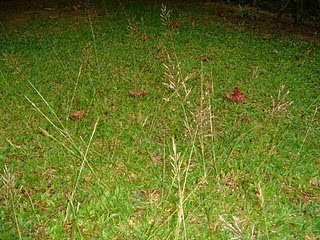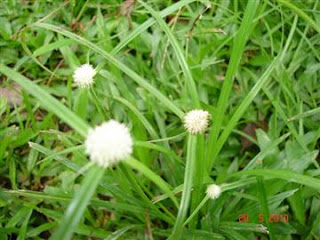 It would appear that if you are small, people tend not to notice you so much. I have these pictures of the little, tiny flowers that bloom away relentlessly and yet virtually unnoticed in my garden and elsewhere, kept away in my picture archives for years. Today I am dedicating this write to them, those that have stood up like sentinels both sides of the pathways, the lawns as well as every nook and cranny....
It would appear that if you are small, people tend not to notice you so much. I have these pictures of the little, tiny flowers that bloom away relentlessly and yet virtually unnoticed in my garden and elsewhere, kept away in my picture archives for years. Today I am dedicating this write to them, those that have stood up like sentinels both sides of the pathways, the lawns as well as every nook and cranny....The first one is a wild orchid which I had saved from a huge tree in front of the house. So, it is not truely wild now. I believe it is an Acriopsis. It has real tiny white petals with purple tips. The flowers may last for about a month which is good by any standard. Indeed, some orchid blooms are known to last that long.

The red and yellow flowers next are actually not so small but still very few people would have cared for them. The pictures were taken while on a trip back to my late mum's dusun (fruit plot) in Kelemak, Malacca. I think they are gorgeous. I would be happy if anyone could identify this red flower. Upon maturity, the center part would open up to reveal and scatter the seeds within.
The Malays call the yellow flowers Simpoh Air scientifically it is known as Dillenia suffruiticosa. I have never found out what "simpoh" means. As such I suspect it may be a local dialect to mean "simbah" (pour) and pour water does make sense anyway. This attractive shrub can grow up to 7 metres tall. The large robust leaves were commonly used before the days of plastic and styrofoam as disposable platters and wrappers to wrap 'tempeh'(soya cake) and 'rojak'(local salad). Apparently the plant can live to 50-100 years!I think I may need to check on this further!!
Next, the lovely pink flowers are from my starfruit tree. I notice there is always a bunch of blooms up the tree. My brother gave me the grafting many years ago. His tree had long gone but mine still thrives without much ado, really. It sure is a hardy tree! No wonder the locals call it Belimbing Besi (Iron Starfruit).
The small white flowers with a tinge of purple are Cordia cylindristachya, commonly known as String Bush. The plant grows everywhere in my garden so much so that I simply refer them as weeds. They grow back after every weeding. You can't really win with them. So, I now take a different stance on it - a motivation for exercise and gardening. They are actually quite beautiful plants growing up to half meter tall forming a cushy carpet if allowed to thrive.


The plant of the tiny while flowers at the axils is a herb known as Andrographis paniculata. The Malays call it Hempedu Bumi (Bile of the Earth)/Pokok Cerita (Plant of Tales) while other locals call it the antibiotic plant. It is indeed the king of bitters. The leaves are used to make tea and is reported to possess astringent, anodyne, tonic and alexipharmic properties and is helpful in dysentery, cholera, diabetes, influenza, bronchitis, piles, gonorrhoea, hepatomegaly, skin disorders, fever and worm infestation , to name a few. Now you know why my Chinese friends call it the antibiotic plant!The plant grows in every nook and cranny in my garden.
Mimosa pudica or locally known as Semalu ("malu" means shy) is also known as touch-me-not. When the leaves are touched they will just retract and fold up. The plant is prickly and a nuisance in the garden. My hubby usually uses the pliers to pull them out of the ground A native of tropical America, I understand (Gosh, how did it get here, I wonder?) It has pink or almost purple flowers looking very fluffy.
The next few flowers are more of grass and weeds often found in my garden. It would probably take me some time to identify them so I am posting them here to give an idea of how many types there are out there in any garden if one care to look around. The shots were taken as best as I could with just an old, ordinary digital camera - Sony Cyber-shot, our very first one, then.
The thistle-like flowers come in white and purple in colour on every plant.

Next is the Kemuncut which I would love to call forget-me not though it really is not. It grows in every open ground. We use to pull the plant out every time we see one in the ground least we would trample on them. The spike would stick to our clothes and time and again we would have to pick them out individually.




.jpg)




1 comment:
The red flower, second picture from top is one which I also found in Manila. Apparently it is called the Money Tree Plant but googling it up has not yielded any results for a scientific name. If you get any success in its identification, please let me know as well. Also the tiny flowers on thin stalks with brown wall in the background, did you find an ID on that one too?
Post a Comment